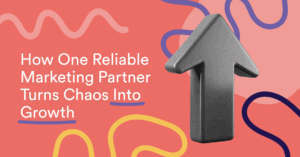How One Reliable Marketing Partner Turns Chaos Into Growth
Tired of vendor bingo? Discover how one reliable marketing partner, flat fees, and a 30-60-90 roadmap can turn chaos into clear, predictable pipeline growth.
Read more
Imagine your newsletter subscriber list as a carefully tended garden. Discover how LinkedIn can be your premium soil for cultivating high-quality connections that genuinely engage with your content. It's time to trade quantity for quality and watch your newsletter flourish.
Growing Your Newsletter In The Garden Of LinkedIn
Remember the thrill of hitting those big email subscriber milestones? 100, 500, 1,000 subscribers – it felt great. But then came the reality check: low open rates, fewer clicks, and a growing list of unsubscribes.
Here’s the cold, hard truth: a newsletter is only as good as its reach. It’s not about how many seeds you scatter, but how well each plant thrives.
The Prize-Hunters’ Trap
Many marketers have fallen into the trap of using tools like KingSumo to build their newsletter lists. Whilst the growth looks impressive – thousands of new subscribers practically overnight – what happens next?
The reason is simple: The list grew with people hunting for prizes – not those genuinely interested in nurturing a connection with your business or content.
Quality Over Quantity: Harnessing LinkedIn’s Power
Here’s a thought for you: 100 carefully cultivated subscribers are worth more than 1,000 randomly scattered seeds.
This is where LinkedIn comes into its own. It’s not just another social media platform – it’s premium soil for growing professional connections. But why is LinkedIn such fertile ground?
Not all gardeners are born with green thumbs. They have to learn how to nurture seeds to flourish. The garden of LinkedIn is similar: here’s how to use it to grow a newsletter people actually want to read:
Why LinkedIn Prospecting Works
Once you’ve sent the invitation, be patient. This approach isn’t about rapidly expanding your list, but about cultivating genuine connections. You’re showing them exactly what they’re signing up for and giving them a choice to be part of your community.
It’s a different pace to viral giveaways or buying email lists, but the results are more than worth it. People who join your list this way are more likely to engage with your content, share your ideas, and potentially become loyal customers or clients.
Consider these industry averages:
These numbers highlight why developing a list of genuinely interested subscribers is crucial. A smaller, engaged audience can yield a far richer harvest than a large, uninterested one.
Automation: Handle with Care
Once you’ve opened up communication channels through LinkedIn messaging, it’s tempting to rely on automation to do the work for you. But remember, no garden thrives on automatic sprinklers alone.
Tools like Dripify can help streamline parts of this process. But use them wisely. Over-automation can make your outreach feel as impersonal as mass-produced bouquets. The goal is to nurture quality connections, not to create a field of lookalikes.
Addressing Concerns: Is This Too Pushy?
Some might view this approach as aggressive. But let’s be real – it’s nowhere near as intrusive as those “Can I have 15 minutes of your time? Here’s my Calendly link” messages everyone loves to hate.
This method offers value upfront. It gives people a clear idea of what they’re signing up for, like offering a tour of your garden before inviting them to join a gardening club. Most importantly, it respects their time and their inbox.
The LinkedIn Prospecting Payoff
Focusing on quality over quantity yields a bountiful harvest:
In short, it creates a newsletter that people actually want to read – a thriving community rather than a neglected plot.
Next Steps for Newsletter Growth
Remember, growing a quality newsletter list isn’t about quick wins. It’s about cultivating relationships, one connection at a time.
What’s your take on this approach? Have you tried using LinkedIn to grow your newsletter? Share your experiences in the comments!
We’d love you to share it with your friends, colleagues or your marketing team.
